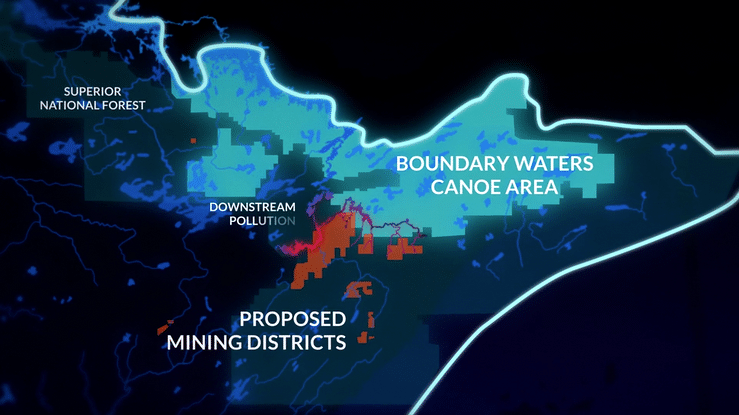The clean energy revolution is here, and proponents of the Twin Metals mine want you to think it can’t happen without a risky copper-nickel mine next to the Boundary Waters.
Witness testimony was abound with references to “critical minerals” during a recent hearing in the U.S. Senate Committee on Energy and Natural Resources that included a representative for Twin Metals. This term describes natural resources needed to produce EV batteries and other advanced clean energy technologies.
Critical minerals have become central to the latest flawed rationale for a risky sulfide-ore copper mine, wherein Twin Metals claims the mine — despite its risks to the Boundary Waters — is necessary to aid the demand for these materials. The reality, however, paints a different picture: The choice between clean energy and protecting the Boundary Waters is a false one.
The proposed sulfide-ore copper mine would be unable to significantly supply critical minerals for clean energy production. Furthermore, even Twin Metals recognizes its mine’s potential risk of irreversible damage to the area. This misled argument can’t hide that sulfide-ore copper mining near the Boundary Waters is disliked by Minnesotans and would be ultimately trivial to clean energy production.
Abundant clean energy and a protected Wilderness are not mutually exclusive
The transition to green energy is inevitable and central to the long-term health of our world’s climate and environment — the Boundary Waters included. However, the minerals from a Twin Metals mine aren't needed to ensure the production of essential clean energy technology. While Twin Metals falsely touts its role in aiding green energy development, the proposed mine itself would demand as much annual power as nearby port city Duluth, Minnesota, and its 80,000 residents and businesses.
Twin Metals seeks to mine low-grade deposits that would hardly contribute to the current annual U.S. demand of copper, nickel, and cobalt, according to a 2019 report from the U.S. Geological Survey. These minerals are either plentifull elsewhere within the U.S. or are easily procurable from long-term allies like Canada and Australia. In other words, a protected supply chain for critical minerals exists without Twin Metals.
Insignificant contributions
Twin Metals claims its mine would play a large role in the inevitable surge in critical minerals demand. However, data shows that a Twin Metals mine would barely put a dent in current demand, and its role would only diminish as future demand rises. The risk to the Boundary Waters, however, is high regardless.
of current annual U.S. copper consumption
of current annual U.S. cobalt consumption
of current annual U.S. nickel consumption
The White House also recently announced plans to heavily invest in bolstering an American supply chain for critical minerals and maintain stringent environmental standards at the same time. These genuine actions contrast with the dubious claims that a mine so close to the Wilderness is necessary. Using the climate crisis to justify a high-pollution mining project is classic greenwashing by an international conglomerate interested only in profit, much like the way Big Oil has begun to embrace clean energy despite still pumping oil.
Twin Metals admits the mine is risky to the valuable and vulnerable Boundary Waters ecosystem
Clean energy components are a positive development for our environment, but trying to extract them near ecologically sensitive areas like the Boundary Waters is a different story. The science behind the risks of sulfide-ore copper mining supports a clear conclusion: The proposed Twin Metals mine would permanently damage the Boundary Waters, including the wildlife within it and the businesses that rely on its pristine waters. The risk is so clear that Twin Metals itself admits to the hazardous nature of mining upstream from the Wilderness.

When asked during the critical minerals hearing about the risks of the Twin Metals project to the BWCA, Twin Metals Chief Regulatory Officer Julie Padilla likened sulfide-ore copper mining in the Rainy River Watershed to driving without a seatbelt:
“... these are industrial activities. Every human activity involves risk and so when we ask simple questions and expect a simple answer, that’s a problem. When I get into a car, I choose whether to put on a seatbelt, I choose whether to take that risk …”
This recognition of risk was immediately bolstered by expert testimony from Dr. Paul Ziemkiewicz, Director of the West Virginia Water Research Institute, who said “by definition, it’ll be wet enough to generate acid mine drainage.”
Twin Metals and the experts agree: its copper mine would pose a risk of significant damage to the Boundary Waters in exchange for an insignificant amount of minerals.
